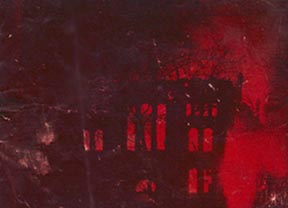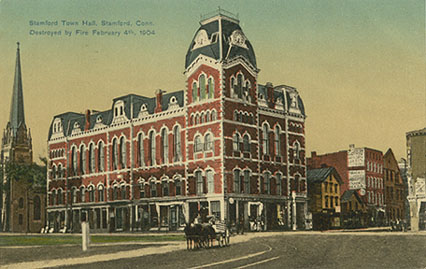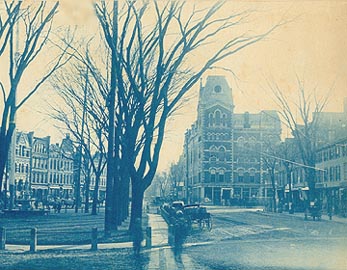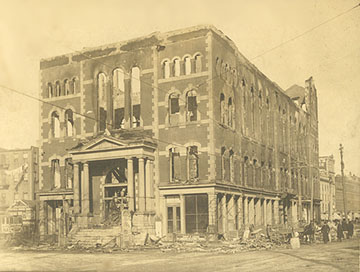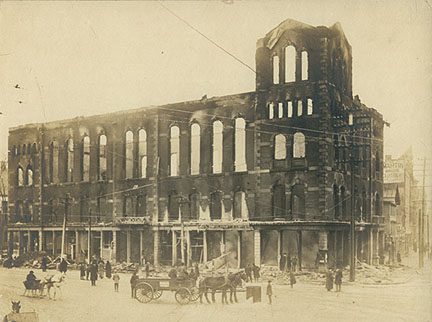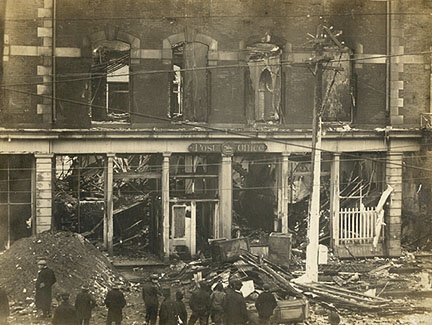| Join | Official Historian | City of Stamford | Blog | About Us | |
| Jewish Historical Society | Civil War Roundtable | Contact Us | |
|
|
|
|
Photo Archivist's Selection of the Month: Summer 2001The Old Town Hall and the 1904 Firearticle for the Stamford Advocate June 1967, called the structure “[An] elephantine brick edifice with a mansard roof and a four-sided bulbous bell tower that rose two stories above the rest of the building at the northeast end. The arched windows and most of the other architectural details were outlined in light-colored brick, giving the impression of a giant, busily decorated birthday cake.”
The Fire
This article tells of the building of the town hall in 1870 and the 1904 fire. Below is another excerpt:
Fortunately, only a few persons were above the ground floor when the fire started. Three officers of the Leeds Council, Order of United American Mechanics, were busy in their lodge room up under the roof at the south end of the building. A roaring inferno blocked the stairs, and they managed to escape through a scuttle in the ceiling and walk across the roof to another scuttle at the north end. Luckily it wasn't locked, and they climbed down through the scenery on the stage of the auditorium and got out of the building. Although the fire started directly over the post office, postal employees carried out all the first class mail. The rest of the mail burned. Public officials were able to salvage considerable quantities of documents from the vaults. Firemen could not get an effective stream of water Into the building for half an hour because the bitter cold weather had frozen the fire hydrants. By the time they got a second stream going, the whole structure was ablaze. Flames leaped into the sky and sparks flew in all directions. With no hope of saving town hall, the firemen concentrated on keeping the fire from spreading. A wooden building to the rear was partially destroyed. Sparks caught in the tower of the wooden Congregational Church across Bank St., and for a time that building seemed doomed. Using their new extension ladder for the third time, the firemen snuffed out the steeple flames. The plate glass window in the C.O. Miller building, then located across the Square, cracked in the heat. At 8 p.m. the bell In the tower struck the hour and then broke from its moorings and plummeted to the basement. It had sounded the death knell of town hall. An hour later, only the four brick walls were standing, and by midnight the fire had consumed its way to the basement, where It was still roaring.” Society member Chet Buttery recently donated these two photos, which prompted this essay. He told us that his grandfather, George Keeler, was a mail dispatcher at the post office and remembered the fire well, not the least because he lost his bicycle, which was stored in the basement.
The loss was estimated at $90,000. The fire inspired the insurance agent Frank B. Gurley to a lively promotional insurance brochure, mentioning that the Town Hall was “…insured for $67,500, all of which the town will receive. The Selectmen previous to the fire had been constantly advised by the narrow minded to reduce the insurance and thus save expense, but their good judgement prevailed and the amount was kept at the original sum.” After this fire, and another serious fire in the Opera House Block on Upper Atlantic Street, the need for improvement and expansion of the fire department became evident. A modern fire alarm system was installed. The custom of call firemen was abolished and a system of permanent firefighters was adopted. Two more fire houses were built, one on Fairfield Avenue, and the other on Lockwood Avenue. Finally, motor apparatus was introduced to Stamford in 1910. Images © Stamford Historical Society Photo Selection of
the Month: The Old Town Hall II Other Photo Archivist Selections of the Month |
|||||
|
|
